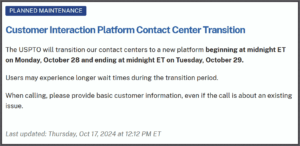
Yes, I realize the subject line doesn’t actually narrow things down very much, in the sense that many USPTO announcements are poorly worded in one way or another. But this one is breathtaking in the extremity of its poor wording. See if you can catch it:
Planned maintenance
Customer Interaction Platform Contact Center Transition
The USPTO will transition our contact centers to a new platform beginning at midnight ET on Monday, October 28 and ending at midnight ET on Tuesday, October 29.
Users may experience longer wait times during the transition period.
(emphasis in original.) Continue reading “poorly worded USPTO announcement”


